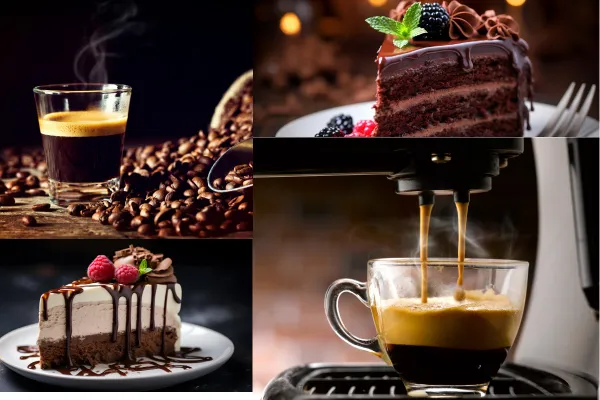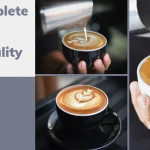If you’ve ever stood behind a Starbucks counter, or simply browsed a café menu, you’ve probably seen “Ristretto” listed as an option. But what exactly is it? I have to admit, even during my time at Starbucks, I didn’t fully get this drink—and frankly, it still leaves me scratching my head at times! It’s often compared to espresso, yet it’s not exactly the same, so let’s dive into the world of ristretto and try to unravel the mystery behind this little coffee enigma.
Table of Contents
Discovery
“Ristretto” comes from the Italian word for “restricted” or “shortened,” which is exactly what this drink is—a shorter version of an espresso. While an espresso is brewed with a standard amount of water, a ristretto uses less water during the extraction process, resulting in a smaller, more concentrated shot.
Unlike espresso, which is balanced between bitterness and sweetness, a ristretto leans heavily into the sweeter, more intense side of coffee. The reduced water means less extraction time, so you get all the good stuff—the rich flavors and smooth notes—without the bitterness that can sometimes come with espresso.

Ristretto Recipe
Ingredients:
- 1 shot (about 1 ounce) of finely ground coffee beans
- Less water than a standard espresso shot
Instructions:
- Start with a very fine grind, even finer than you would use for a regular espresso. This helps control the flow of water and the flavor extraction.
- Pack the ground coffee tightly into your espresso machine’s portafilter.
- Brew the ristretto by allowing less water to pass through the coffee grounds, typically about half the amount used for a standard espresso shot.
- The extraction process should be quicker, typically 15-20 seconds, compared to the 25-30 seconds for an espresso.
- Serve in a small cup and savor the more concentrated flavors.
How to Brew it Perfect
The key to a perfect drink lies in its “short” extraction time. By using less water, you allow only the first part of the espresso shot to be pulled—the part with the most intense flavors and natural sweetness.
- Grind Size: The coffee should be ground even finer than for a standard espresso shot. This ensures that the water flows through the grounds at the right speed to extract only the best flavors.
- Short Extraction: It should be brewed in about 15-20 seconds. The shorter brew time means the water interacts less with the coffee, which limits bitterness and results in a sweeter, more concentrated shot.
- Pressure: Just like with an espresso, pressure is essential. A well-brewed drink still needs the same high pressure (around 9 bars) to ensure the rich flavor and texture are extracted.
The result is a smaller, sweeter, and often smoother shot of coffee that’s perfect for those who want the intensity of espresso without the bitterness.
What Makes it Bad
Because it relies on such a precise brewing process, there are a few things that can go wrong:
- Too Much Water: If too much water is used, the shot becomes an espresso and loses the defining characteristic of a drink—the sweet, concentrated flavor.
- Over-Extraction: Brewing it for too long can lead to over-extraction, resulting in bitterness that defeats the purpose of a drink.
- Improper Grind Size: If the grind is too coarse, the water will flow through too quickly, under-extracting the coffee and leaving it weak and watery.
The goal is to capture only the best flavors, avoiding bitterness and watery extractions that can ruin the drink experience.
Ristretto vs. Espresso: What’s the Difference?
So, if you’re like me and found yourself asking, “Isn’t it just a smaller espresso?”—well, the answer is both yes and no. Here’s how they differ:
- Water: It uses less water than an espresso, resulting in a smaller, more concentrated shot.
- Brew Time: The extraction time for it is shorter, usually 15-20 seconds, while an espresso takes 25-30 seconds.
- Flavor: Because less water is used, It tends to be sweeter and less bitter than espresso, showcasing the richer, more nuanced flavors of the coffee beans.
- Serving Size: It is typically smaller than a regular espresso shot, often around 0.75 to 1 ounce compared to espresso’s 1 to 1.25 ounces.
Ristretto is for those who love espresso but want a more concentrated flavor without the bitterness that sometimes comes with longer extractions.
Caffeine Content
Surprisingly, despite its smaller size, a ristretto contains roughly the same amount of caffeine as a standard espresso shot, about 63 milligrams. Since the ristretto is more concentrated, it may feel stronger, but it delivers the same caffeine punch.
Sugar
A ristretto’s natural sweetness means that many drinkers enjoy it without adding any sugar. However, for those who find even this small shot too intense, a little sugar can help round out the flavors.
Calories and Macros
| Nutrient | Amount per 1 oz (30 ml) Ristretto |
| Calories | 2-5 |
| Protein | 0 grams |
| Carbohydrates | 0 grams |
| Fat | 0 grams |
| Caffeine | 63 milligrams |
Much like espresso, ristretto is virtually calorie-free unless you add sugar, milk, or other extras.
Interesting Facts about Ristretto
- Short and Sweet: The word “ristretto” means “restricted” or “shortened” in Italian, referring to the limited amount of water used in the brewing process.
- Not a “Weak” Espresso: Many people mistakenly think ristretto is a weaker espresso, but it’s actually more concentrated, offering more of the coffee’s natural sweetness and less bitterness.
- A Popular Option in Coffee Blends: Because of its concentrated flavor, ristretto is often used as the base for other coffee drinks, especially in specialty coffee shops.
- Size Matters: The ristretto is smaller than a standard espresso, but the flavors are often richer and more intense, packing more punch in a smaller shot.
Conclusion
Ristretto may still be a bit of a mystery to many (and I’ll admit, I still don’t fully get it at times!), but it’s a fascinating coffee drink that’s all about delivering concentrated flavor. If you find espresso a bit too bitter or harsh, ristretto might be a more enjoyable alternative thanks to its natural sweetness and smooth finish.
Whether you’re a seasoned coffee drinker or still trying to wrap your head around the differences between espresso and ristretto, this “shortened” coffee experience offers a unique flavor that’s worth trying. Next time you’re in a café, don’t hesitate to order one and savor the concentrated beauty of ristretto—if you’re still confused, you’re not alone, but at least you’ll enjoy the mystery in a cup!








